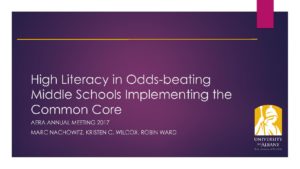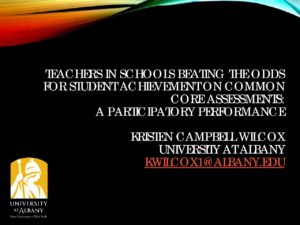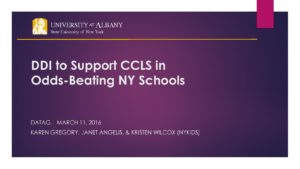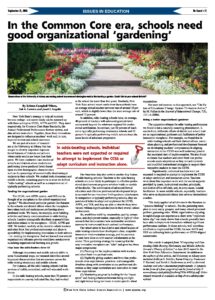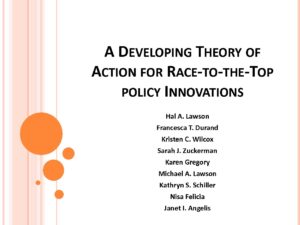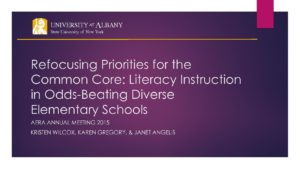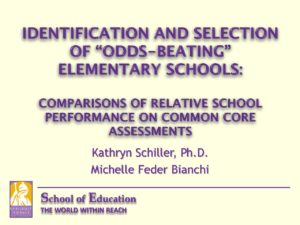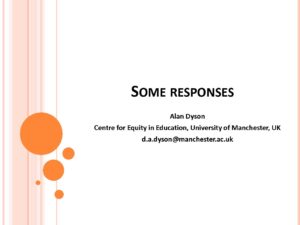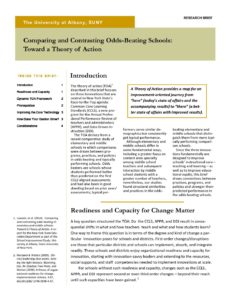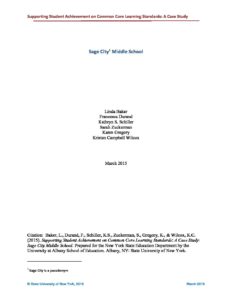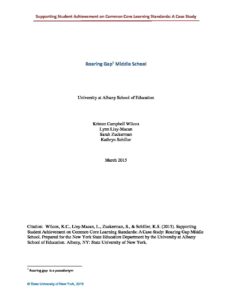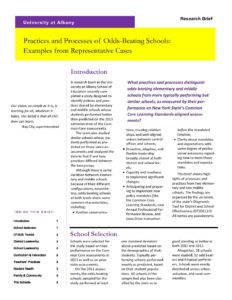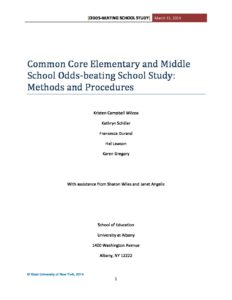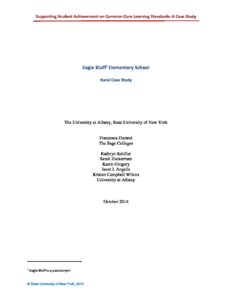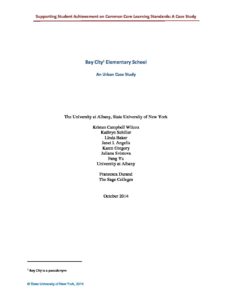Topic: Common Core
This presentation identifies the school practices and polices found in elementary and middle schools whose students exceeded performance expectations on the 2012-13 New York State assessments, which were the first aligned with the Common Core Standards.
This presentation identifies the school practices and polices found in elementary and middle schools whose students exceeded performance expectations on the 2012-13 New York State assessments, which were the first aligned with the Common Core Standards.
This presentation identifies the school practices and polices found in elementary and middle schools whose students exceeded performance expectations on the 2012-13 New York State assessments, which were the first aligned with the Common Core Standards.
This presentation identifies the school practices and polices found in elementary and middle schools whose students exceeded performance expectations on the 2012-13 New York State assessments, which were the first aligned with the Common Core Standards.
Literacy practices among “odds-beating” middle schools implementing the Common Core.
Literacy practices among “odds-beating” middle schools implementing the Common Core. The presentation explores the ways that teachers’ literacy instruction practices, in the context of attempting to align to the Common Core Learning Standards, show evidence of attention to developing high literacy.
The primary purpose for the proposed research was to identify the school practices and policies found in elementary and middle schools whose students exceeded performance expectations on New York State Common Core assessments (as well as those that were used prior to Common Core).
The primary purpose for the proposed research was to identify the school practices and policies found in elementary and middle schools whose students exceeded performance expectations on New York State Common Core assessments (as well as those that were used prior to Common Core).
The study identifies the school practices and policies found in elementary and middle schools whose students exceeded performance expectations on the 2012-13 New York State assessments.
The study identifies the school practices and policies found in elementary and middle schools whose students exceeded performance expectations on the 2012-13 New York State assessments. This presentation considers how educators approach data-driven instruction, the types of data used and for what purposes, and practices or processes to support data-driven instruction.
This article discusses important organizational features of districts and schools whose early results on the Common Core Assessments are better than their peer schools.
This article discusses important organizational features of districts and schools whose early results on the Common Core Assessments are better than their peer schools. The Common Core State Standards, Annual Professional Performance Review system and Data-Driven Instruction can be thought of as transplants to the school organizational “garden.” Findings suggest particular garden-like features in the schools and district offices where the transplants have taken hold and students are performing above predicted levels.
Presentation of the findings from a comparative study of New York State schools designed to investigate implementation of Common Core Learning Standards (CCLS) and the Annual Professional Performance Review (APPR) as they relate to student performance outcomes on CCLS-aligned assessments.
Presentation of the findings from a comparative study of New York State schools designed to investigate implementation of Common Core Learning Standards (CCLS) and the Annual Professional Performance Review (APPR) as they relate to student performance outcomes on CCLS-aligned assessments.
Presentation of the findings from a comparative study of New York State schools designed to investigate implementation of Common Core Learning Standards (CCLS) and the Annual Professional Performance Review (APPR) as they relate to student performance outcomes on CCLS-aligned assessments.
Presentation of the findings from a comparative study of New York State schools designed to investigate implementation of Common Core Learning Standards (CCLS) and the Annual Professional Performance Review (APPR) as they relate to student performance outcomes on CCLS-aligned assessments.
Presentation of the findings from a comparative study of New York State schools designed to investigate implementation of Common Core Learning Standards (CCLS) and the Annual Professional Performance Review (APPR) as they relate to student performance outcomes on CCLS-aligned assessments.
Presentation of the findings from a comparative study of New York State schools designed to investigate implementation of Common Core Learning Standards (CCLS) and the Annual Professional Performance Review (APPR) as they relate to student performance outcomes on CCLS-aligned assessments.
Presentation of the findings from a comparative study of New York State schools designed to investigate implementation of Common Core Learning Standards (CCLS) and the Annual Professional Performance Review (APPR) as they relate to student performance outcomes on CCLS-aligned assessments.
Presentation of the findings from a comparative study of New York State schools designed to investigate implementation of Common Core Learning Standards (CCLS) and the Annual Professional Performance Review (APPR) as they relate to student performance outcomes on CCLS-aligned assessments.
Presentation of the findings from a comparative study of New York State schools designed to investigate implementation of Common Core Learning Standards (CCLS) and the Annual Professional Performance Review (APPR) as they relate to student performance outcomes on CCLS-aligned assessments.
Presentation of the findings from a comparative study of New York State schools designed to investigate implementation of Common Core Learning Standards (CCLS) and the Annual Professional Performance Review (APPR) as they relate to student performance outcomes on CCLS-aligned assessments.
A systematic examination of the ways a variety of schools have approached and responded to the Common Core Learning Standards (CCLS) and the Annual Professional Performance Review (APPR) systems, both part of the Race to the Top reform agenda.
The Common Core Odds-Beating Studies were developed in collaboration between a team of researchers at the University at Albany and the New York State Education Department. The study began in the recognition that there was a need for research investigating the process and practices in schools with relatively better outcomes on the Common Core-aligned assessments first implemented in the state in the 2011-2012 school year. At the time of this study, there had been no systematic examinations of the ways a variety of schools have approached and responded to the Common Core Learning Standards (CCLS) and the Annual Professional Performance Review (APPR) systems, both part of the Race to the Top reform agenda.
This case is one part of a comparative study of New York State middle schools designed to investigate implementation of Common Core Learning Standards (CCLS) and the Annual Professional Performance Review (APPR) as they relate to student performance outcomes on CCLS-aligned assessments. The study sample included both odds-beating and typically performing schools.
The Common Core Odds-Beating Studies were developed in collaboration between a team of researchers at the University at Albany and the New York State Education Department. The study began in the recognition that there was a need for research investigating the process and practices in schools with relatively better outcomes on the Common Core-aligned assessments first implemented in the state in the 2011-2012 school year. At the time of this study, there had been no systematic examinations of the ways a variety of schools have approached and responded to the Common Core Learning Standards (CCLS) and the Annual Professional Performance Review (APPR) systems, both part of the Race to the Top reform agenda.
This case is one part of a comparative study of New York State middle schools designed to investigate implementation of Common Core Learning Standards (CCLS) and the Annual Professional Performance Review (APPR) as they relate to student performance outcomes on CCLS-aligned assessments. The study sample included both odds-beating and typically performing schools.
The Common Core Odds-Beating Studies were developed in collaboration between a team of researchers at the University at Albany and the New York State Education Department. The study began in the recognition that there was a need for research investigating the process and practices in schools with relatively better outcomes on the Common Core-aligned assessments first implemented in the state in the 2011-2012 school year. At the time of this study, there had been no systematic examinations of the ways a variety of schools have approached and responded to the Common Core Learning Standards (CCLS) and the Annual Professional Performance Review (APPR) systems, both part of the Race to the Top reform agenda.
A systematic examination of the ways a variety of schools have approached and responded to the Common Core Learning Standards (CCLS) and the Annual Professional Performance Review (APPR) systems, both part of the Race to the Top reform agenda.
The Common Core Odds-Beating Studies were developed in collaboration between a team of researchers at the University at Albany and the New York State Education Department. The study began in the recognition that there was a need for research investigating the process and practices in schools with relatively better outcomes on the Common Core-aligned assessments first implemented in the state in the 2011-2012 school year. At the time of this study, there had been no systematic examinations of the ways a variety of schools have approached and responded to the Common Core Learning Standards (CCLS) and the Annual Professional Performance Review (APPR) systems, both part of the Race to the Top reform agenda.
A systematic examination of the ways a variety of schools have approached and responded to the Common Core Learning Standards (CCLS) and the Annual Professional Performance Review (APPR) systems, both part of the Race to the Top reform agenda.
The Common Core Odds-Beating Studies were developed in collaboration between a team of researchers at the University at Albany and the New York State Education Department. The study began in the recognition that there was a need for research investigating the process and practices in schools with relatively better outcomes on the Common Core-aligned assessments first implemented in the state in the 2011-2012 school year. At the time of this study, there had been no systematic examinations of the ways a variety of schools have approached and responded to the Common Core Learning Standards (CCLS) and the Annual Professional Performance Review (APPR) systems, both part of the Race to the Top reform agenda.
A systematic examination of the ways a variety of schools have approached and responded to the Common Core Learning Standards (CCLS) and the Annual Professional Performance Review (APPR) systems, both part of the Race to the Top reform agenda.
The Common Core Odds-Beating Studies were developed in collaboration between a team of researchers at the University at Albany and the New York State Education Department. The study began in the recognition that there was a need for research investigating the process and practices in schools with relatively better outcomes on the Common Core-aligned assessments first implemented in the state in the 2011-2012 school year. At the time of this study, there had been no systematic examinations of the ways a variety of schools have approached and responded to the Common Core Learning Standards (CCLS) and the Annual Professional Performance Review (APPR) systems, both part of the Race to the Top reform agenda.
A systematic examination of the ways a variety of schools have approached and responded to the Common Core Learning Standards (CCLS) and the Annual Professional Performance Review (APPR) systems, both part of the Race to the Top reform agenda.
The Common Core Odds-Beating Studies were developed in collaboration between a team of researchers at the University at Albany and the New York State Education Department. The study began in the recognition that there was a need for research investigating the process and practices in schools with relatively better outcomes on the Common Core-aligned assessments first implemented in the state in the 2011-2012 school year. At the time of this study, there had been no systematic examinations of the ways a variety of schools have approached and responded to the Common Core Learning Standards (CCLS) and the Annual Professional Performance Review (APPR) systems, both part of the Race to the Top reform agenda.
This case is one part of a comparative study of New York State elementary schools designed to investigate implementation of Common Core Learning Standards (CCLS) and the Annual Professional Performance Review (APPR) as they relate to student performance outcomes on CCLS-aligned assessments. The study sample included both odds-beating and typically performing schools.
The Common Core Odds-Beating Studies were developed in collaboration between a team of researchers at the University at Albany and the New York State Education Department. The study began in the recognition that there was a need for research investigating the process and practices in schools with relatively better outcomes on the Common Core-aligned assessments first implemented in the state in the 2011-2012 school year. At the time of this study, there had been no systematic examinations of the ways a variety of schools have approached and responded to the Common Core Learning Standards (CCLS) and the Annual Professional Performance Review (APPR) systems, both part of the Race to the Top reform agenda.
This case is one part of a comparative study of New York State elementary schools designed to investigate implementation of Common Core Learning Standards (CCLS) and the Annual Professional Performance Review (APPR) as they relate to student performance outcomes on CCLS-aligned assessments. The study sample included both odds-beating and typically performing schools.
The Common Core Odds-Beating Studies were developed in collaboration between a team of researchers at the University at Albany and the New York State Education Department. The study began in the recognition that there was a need for research investigating the process and practices in schools with relatively better outcomes on the Common Core-aligned assessments first implemented in the state in the 2011-2012 school year. At the time of this study, there had been no systematic examinations of the ways a variety of schools have approached and responded to the Common Core Learning Standards (CCLS) and the Annual Professional Performance Review (APPR) systems, both part of the Race to the Top reform agenda.



